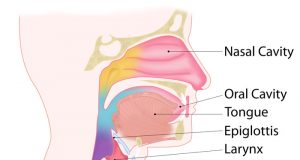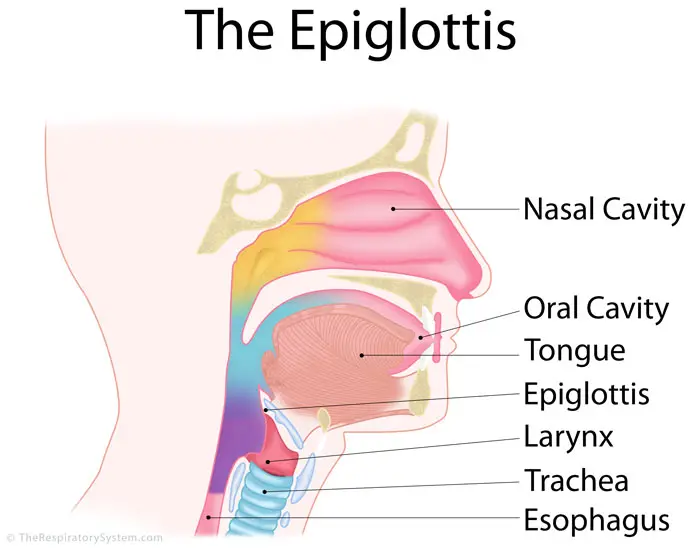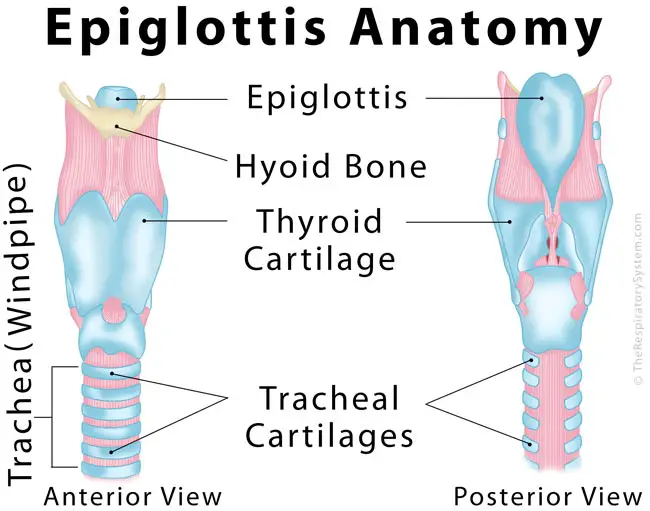Published on December 12th 2016 by admin under Uncategorized
What is the Epiglottis
The epiglottis is a cartilaginous flap covering the opening of the windpipe during swallowing to prevent food from entering the lungs [1].
Where is the Epiglottis Located
The flat, leaf-like structure is attached to the superior end of the larynx (voice box), protruding into the pharynx, just behind the root of the tongue, in its relaxed state [2].
Anatomy of the Epiglottis
Origin and Structure
Visible around the 5th week of fetal development, the elastic cartilage flap originates from the fourth pharyngeal arch. Its lingual surface is covered by mucus membrane [3], with the anterior surface consisting of non-keratinized stratified squamous epithelium, similar to the mouth and pharynx tissues, while the posterior surface is covered in pseudostratified columnar epithelium, similar to the tissues that line the larynx [2].
The epiglottis is visible from the outside, posterior to the tongue, appearing like a flat flap, beneath the uvula.
Epiglottis PictureSometimes, the epiglottis may be high-rising and elongated, but it is completely harmless, only more visible from the outside when the mouth is open [4]. It is usually seen in children, but may be detected in adults as well.
Ligamentary Attachments
When the epiglottis is in the resting position, it is held by the thyroepiglottic and the hyoepiglottic ligaments. The inferior part of the epiglottis is connected to the thyroid cartilage by the thin, small thyroepiglottic ligament, while the tiny hyoepiglottic ligament serves as a connection between the superior region’s front surface and the hyoid bone [2].
Associated Structures
The median glossoepiglottic folds attach the epiglottis to the tongue [5], while the lateral glossoepiglottic folds connect it to the pharynx [6] and the aryepiglottic folds attach its sides to the arytenoid cartilages [3].
The depressions, between the surface of the epiglottis adjacent to the tongue and the root of the tongue, on the two sides of the median glossoepiglottic fold, are known as the vallecula. There are some taste buds on the epiglottis, innervated by vagus nerve fibers form the inferior ganglion [3].
Epiglottis X-RayWhat are the Functions of the Epiglottis
In the Respiratory System
The flexible flap remains in its resting position during inhalation, letting the air enter the lungs through the larynx and windpipe.
In the Digestive System
During the process of swallowing, the extrinsic muscles connected with the larynx move the epiglottis up so it can lay flat over the laryngeal opening, making the food safely pass through the esophagus, instead of entering the windpipe. Afterwards, the muscles relax, so the epiglottis can come back to its original position [7]. If it malfunctions or fails to close properly, it would make you cough and choke every time you swallow.
The cartilaginous structure also helps with speech production in some languages [8].
Associated Conditions
Epiglottitis (Swollen Epiglottis): A rare, yet potentially life-threatening condition, occurring due to some infection or injury, epiglottitis is characterized by swelling, redness, and inflammation of the epiglottis, which may block the airflow to your lungs [9]. Common symptoms include hoarseness of voice and pain during swallowing [10]. It is more common among children, often caused by the bacteria Haemophilus influenzae type b [11]. So, newborns are vaccinated to prevent the infection. Severe cases may even need an intubation to avoid long-term problems [12].
An Omega Shaped Epiglottis: Often a characteristic sign of a condition called laryngomalacia, it refers to an abnormal curled up shape of the epiglottis that may cause problems during inhalation [13]. Laryngomalacia, one of the common causes of noisy breathing among infants, is a congenital malformation where the laryngeal tissues are soft and floppy, collapsing over the airway during breathing.
Cancers Affecting the Area: The epiglottis may be severely affected by head and neck cancer, as well as malignancies of the throat, pharynx, larynx, and supraglottis. In such cases, an epiglottic reconstruction surgery may be carried out to prevent abnormal swallowing and aspiration of food in the lungs.
References
- http://kidshealth.org/en/kids/word-epiglottis.html
- http://www.innerbody.com/image_digeov/dige02-new2.html
- https://www.kenhub.com/en/library/anatomy/epiglottis
- https://www.ncbi.nlm.nih.gov/pmc/articles/PMC4335119/
- https://www.kenhub.com/en/atlas/median-glossoepiglottic-fold
- https://radiopaedia.org/articles/epiglottis
- https://www.getbodysmart.com/ap/respiratorysystem/larynx/epiglottis/tutorial.html
- http://www.healthline.com/human-body-maps/epiglottis
- http://www.mayoclinic.org/diseases-conditions/epiglottitis/basics/definition/con-20027854
- http://patient.info/in/health/epiglottitis-leaflet
- http://www.healthline.com/health/epiglottitis#Overview1
- http://emedicine.medscape.com/article/763612-treatment
- http://emedicine.medscape.com/article/1002527-overview











I have the same condition and have been told the it has no cure. Kindly advise.
What causes vascularity of epiglottis and what can you do to prevent it worsening diagnosed after spitting small amounts of blood
i feel like my epiglottis is swollen. i dont have the symptoms of epiglottitis. when i lie down i feel the sensation of that area closing off and i cant breathe through my nose. it does feel a little irritated and i have a little harsh cough.
I have the same thing going on did it ever heal for you also do you feel chest pain and back pain between the shoulder blades?
I have the same issue I’m going to the doctor tomorrow.
I had surgery for a coroited artery tumor and i have acough since surgery seems like i am gasbing for air and gurgaling when i drink liquids and it feels like i am half way breathing in my throat .
How long does it take to heal
Will sleeping on the side prevent sinus mucas from entering the lungs?